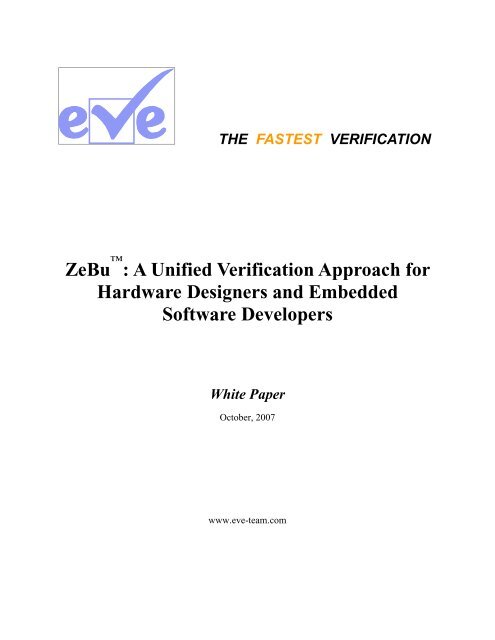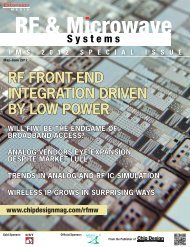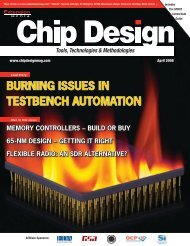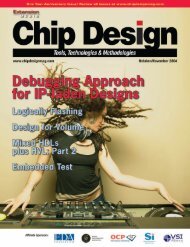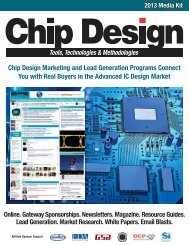Download - Chip Design
Download - Chip Design
Download - Chip Design
Create successful ePaper yourself
Turn your PDF publications into a flip-book with our unique Google optimized e-Paper software.
ZeBu : A Unified Verification Approach for Hardware <strong>Design</strong>ers and Embedded Software DevelopersFigure 4. ZeBu users perform hardware verification and software validation in parallel- ahead of firstsilicon. This translates directly into a significant time to market advantage.ZeBu Operating ModesIn order to provide the most value for each of these applications ZeBu supports several operating modesthat help exploit Zebu’s performance throughout the design cycle. The 7 different operating modes are asfollows:Co-emulation with commercial HDL simulators: A co-emulation link connects ZeBu to anyVHDL/Verilog simulator compliant with the IEEE Verilog PLI interface, such as NC-SIM , VCS andModelSim. Specman Elite and Vera are also supported via the HDL simulator.Co-emulation with C/C++/SystemC at Signal-level: ZeBu provides a C/C++ API with which one cancreate efficient C/C++ test benches to stimulate the design-under-test at the cycle level. The C++ APIalso supports the connection to a SystemC model at the cycle/event level or to an Instruction SetSimulator (ISS).Co-emulation with C++/SystemC/SystemVerilog at Transaction-Level: When the design-under-testincludes bus interfaces (such as Ethernet, PCI, USB, Sonet…), it is possible to stimulate it with C++ testbenches at transaction level (i.e. with high level data such as frames, packets or blocks) instead of atsignal level to minimize the amount of data exchanged between the host PC and the ZeBu-XL board. TheC++ API also supports the connection to a SystemC model at transaction level (through channels).Test Vectors: This pattern-based mode accelerates the regression testing of designs before tape-out. Apattern file, captured during HDL or C/C++ co-emulation, can be played back at higher speed without theHDL simulator or the C/C++ test bench present. The pattern execution tool detects output signaldifferences between the expected responses and the current values provided by the emulated design.Emulation with Synthesizable Test Bench: A synthesizable test bench can be embedded in the FPGA ofthe RTB to enable emulation at several MHz. This mode provides the best level of performance sincethere is no interaction with any external software or hardware components. EVE provides a catalog ofwww.eve-team.com 7 EVE White Paper
ZeBu : A Unified Verification Approach for Hardware <strong>Design</strong>ers and Embedded Software Developerssynthesizable memory models from Micron and Samsung.Emulation with Software Debugger Control. The emulated design can be connected via the Z-SmartICE interface to any software debugger via a JTAG cable or JTAG transactor. The debugger willthen be in control of the software execution.In-Circuit Emulation with Target System and/or Hard IP Cores: In this mode, the emulated designunder-testis cabled to the target system, which provides all stimulus and control. One or more hard IPcores can also be included in the system model and speed-bridges can connect the design to real-timeinterfaces. A built-in logic analyzer running at up to 15 MHz can trace the design states over longemulation runs. Complex triggers can be added to control the tracing mechanism.Multi-mode Operation: ZeBu also supports combinations of the modes outlined above. For example, amulti-mode test environment could include a synthesizable test bench mapped in the RTB, an applicationprogram embedded in a DRAM synthesizable model, a a set of protocol transactors (USB, Ethernet,Audio, etc.) driven by C++ models executed on the host PC/Linux, a JTAG transactor connected to a S/Wdebugger running on a PC/Windows and an LCD transactor displaying the LCD image stream directly onthe host PC.SummaryUnprecedented device complexity and embedded software content are driving the need for a newhardware-assisted verification approach. ZeBu is a breakthrough architecture that combines the strengthsof traditional emulation and rapid prototyping into a unified platform for both hardware and embeddedsoftware development. For the first time a single platform and design representation can satisfy the needsof both these applications, enabling hardware designers and software developers to communicate andcollaborate in a way that was never possible before. The net benefit of ZeBu’s unifying approach is toaccelerate hardware/software integration well ahead of first silicon, reduce unnecessary re-spins andsoftware revisions, and shorten time to market.With a highly cost-effective architecture, ZeBu makes emulation more accessible than ever beforeaccessibleto both SoC designers and embedded software developers, accessible throughout the designcycle, and accessible by groups with modest EDA budgets. Overall, ZeBu clearly provides the best returnon investment of any hardware-assisted verification approach.ZeBu is a trademark of EVE USA, Inc. All other company, product or service names mentioned herein are trademarks of their respective holders andshould be treated as such. All rights reserved. ©2005 EVE USA, Inc.www.eve-team.com 8 EVE White Paper


